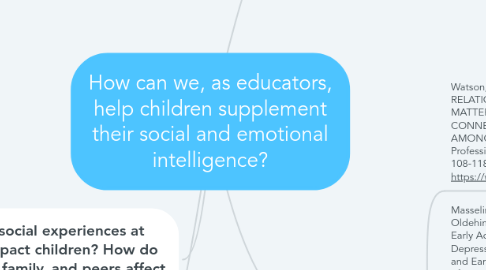
1. How can social experiences at school impact children? How do teachers, family, and peers affect that?
1.1. "researchers have begun identifying school connectedness as a salient factor in reducing the likelihood that adolescents will engage in health compromising behaviors and improving students’ perception of personal adolescent well-being.”
1.1.1. school connectedness does improve an adolescent’s self-esteem. educators have a responsibility in helping students’ social and emotional development, and that they have an opportunity to improve students’ wellness.
1.2. "Peers play a complex role in the lives of adolescents. On the one hand, peers can be sources of interpersonal stress, which has been proposed to be one of the leading causes of depressive symptoms during adolescence. On the other hand, adolescents also increasingly rely on their peers, and peers become the most important source of social contact and social support."
1.2.1. Adolescents' social wellness is connected to their self-esteem, which studies show is also connected to their relationships with peers. It is extremely important that schools promote social wellness, and that teachers provide opportunities for students to work together and create positive relationships.
1.3. “Classrooms with warm teacher-child relationships promote deep learning among students: children who feel comfortable with their teachers and peers are more willing to grapple with challenging material and persist at difficult learning tasks. Conversely, when teachers poorly manage the social and emotional demands of teaching, students demonstrate lower performance and on-task behavior.”
1.3.1. Teachers are just as responsible for the emotional well-being of a student as their peers and family are. Teachers need to look within themselves and make sure they are in a good emotional space. Educators set the tone for the classroom and need to be aware of their social and emotional needs, so they can help students with their social needs.
1.4. “Parent-adolescent conflict was significantly associated with same-day school problems. Separate analyses showed that both mother-adolescent and father-adolescent conflicts were associated with school problems on the same day...parent-adolescent conflict predicted next-day school problems.”
1.4.1. “Children with secure attachment early on were more socially competent throughout their lives...better able to negotiate the complex dynamics of adolescent social network.”
1.4.1.1. Family relationships directly affect children and their social abilities, which in turn affects their ability in school. It's extremely important for parents to parent with an authoritative style instead of authoritative. Conflict at home can have a negative social impact on children.
2. Solution
2.1. Teachers cannot control a student's family life, but they can significantly impact their learning environment and school connectedness.
2.1.1. Teachers should participate in social and emotional training. Studies have shown that a teacher's emotional state affects the students and the class environment. If teachers can understand their emotional state better, they can create an uplifting classroom environment and better understood students' needs.
2.1.2. Teachers can create lessons about different cultures. It will help students be more open-minded towards students. This can improve social support between students.
2.1.3. Take a stern no-bullying stance. Do not allow any malicious teasing or mocking of students.
3. Problem of Practice
3.1. Oftentimes, children feel that the classroom is not the place for them. They feel like they don’t belong. This could be for a variety of reasons. Perhaps they are neglected and/or abused. Maybe they’re from a different culture, or maybe they live in poverty and they don’t have access to the same supplies as children in middle to upper class households. In the textbook “Child Development and Education,” it states that “not all children have access to a high-quality education, a safe environment, and encouragement for pursuing their dreams. One reason for these discrepancies is that children and families are treated differently according to their ethnicity, race, religion, sexual orientation, and national origin.” In the past, schools have struggled to be inclusive and didn’t make an effort to features all cultures, to accommodate children with different backgrounds and/or learning disabilities, and other non-conforming characteristics. All children are intelligent and have something to offer. However, due to what I’ve just described, they can feel stupid or ostracized. It is important to recognize how we can build confidence in children and create a warm, inclusive environment.
3.1.1. There is a link between self-esteem and depressive symptoms
3.1.1.1. self-esteem tends to decrease during early adolescence
3.1.1.1.1. a lack of social support in challenges faced
3.1.1.1.2. a lack of social network
3.1.1.1.3. lack of successful integration in social networks
